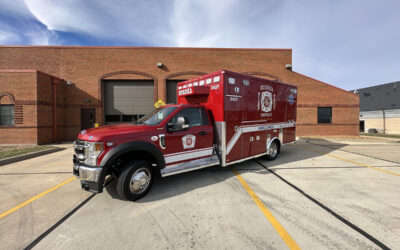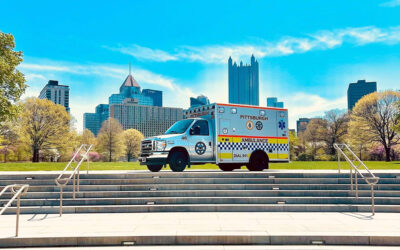By Alan M. Petrillo

Road Rescue built four Type 1 ambulances for Lexington County (SC) EMS on Dodge 4500 4×2 Ultramedic chassis with Liquid Spring rear suspensions. (Photo courtesy of Road Rescue.)
Lexington County (SC) EMS runs between 45,000 and 50,000 calls a year, covering a population of 298,000 in 758 square miles that include a city, small towns, and rural areas intersected by Interstates I-20 and I-26. Staffing Lexington County’s 30 advanced life support (ALS) and basic life support (BLS) ambulances are 73 paramedics and 100 emergency medical technicians (EMTs).
Previously, Lexington County’s rigs were built on Ford F-550 chassis, then on International chassis, until the department finally settled on the Dodge 4500 4×2 chassis, says Magen Hallman, deputy chief of operations. “At the end of 2018, we decided to design an ambulance that provides the greatest safety for our staff and the patients,” Hallman says, “so we set up a committee to determine what that safer truck would look like.”
Related
- Margate-Coconut Creek (FL) Fire Rescue Gets Two New Wheeled Coach Type 1 Rigs
- REV Ambulance Group Delivers 81 Ambulances to FDNY to Bolster COVID-19 Responses
- Life as an Emergency Response Medic in Southern Pottawatomie County (OK)
Brittan Rininger, a Lexington County EMS lieutenant and member of the truck committee, says the committee put together a list that included both the department’s needs and wants, and attended an EMS conference to examine ambulances made by different manufacturers. “We then saw a truck in a neighboring county that embodied our concepts,” Rininger says, “and we tweaked that design to be our own. In August of 2019, three of our committee members went to the Road Rescue complex in Florida, toured their facility, saw some of their ambulances, and sat down with them to discuss our specs. After we returned, we issued a request for proposals, and after receiving several of them, awarded the contract for four Type 1 ambulances to Road Rescue.”
Michael Guzman, vice president of ambulance sales for Atlantic Emergency Solutions, who sold the four Road Rescue rigs to Lexington County, says the department did its homework well in researching what major fleets around the country were doing in terms of ambulance crew safety and design. “When they saw the design of a Wheeled Coach ambulance, they took that design and mimicked a lot of the elements, like the door forward design on the curb side, a raised countertop and seatbelts so they could backboard a patient over the CPR seat, and a sliding attendant seat on the curb side,” Guzman points out. “All seating in the rigs have IMMI Per4Max four point harness systems.”

Lexington County had Road Rescue design a raised countertop and seatbelts on the driver’s side of the interior so medics could backboard a patient over the CPR seat if necessary. (Photo courtesy of Lexington County EMS.)
Holly Russell, outside brand manager for Road Rescue, says the four Type 1 Road Rescue ambulances are identical, each built on a Dodge 4500 4×2 Ultramedic chassis with a wheelbase of 192-1/2 inches, an overall length of 168 inches, and an overall height of 98 inches. “The ambulances have 72 inches of headroom in the patient module, and an aisle width of 46 inches,” Russell points out. “Gross vehicle weight rating is 16,500 pounds, and the rigs have Liquid Spring rear suspensions.”
The Road Rescue ambulances are built with a roll cage design safety structure, Russell notes, “which produces fewer body seams than any other ambulance design. Also, all hinges are inside the door skins for superior resistance to rollover, the rigs are 100 percent aluminum, with one-eighth-inch solid aluminum wall panels on the front, back and sides of the box, with a one inch bend over the corners for added strength.”
Each rig has a Safety Vision 2 camera system, HiViz Fire Tech LED scene lighting, and a REV Group Cool Bar™ that incorporates an air conditioner, gas condenser, fans, and emergency warning lights into a single unit.
The interior of the patient module has a Medicool dual temperature refrigerator in an upper curbside cabinet, a Stryker Power-LOAD cot, and IMMI Per4Max seat harnesses with controlled deceleration technology on the attendant seat, CPR seat and the curbside EVS mobility seat on a track that slides fore and aft, and swivels, Russell says.

The new Lexington County EMS rigs have a Stryker Power-LOAD cot in the center of the patient module, and IMMI Per4Max four point harness systems on all the seating. (Photo courtesy of Lexington County EMS.)
Rininger notes that the new design of the Road Rescue rigs reduced the number of oxygen tanks they carry from six to three, changed from a side mount to a center mount stretcher, went to full metal cabinetry instead of wood, and eliminated the bench seat that was replaced by the sliding/swiveling EVS seat. “We also added a Zico power lift for the oxygen bottles,” she says, “and moved the spine boards, stair chair, and portable stretcher to the curb side of the ambulance to safely keep the medics out of the roadway at an accident scene.”

Instead of a bench seat on the curb side, the Road Rescue rigs for Lexington County have an EVS mobility seat that swivels and slides fore and aft on a track set into the floor. Note the door forward design on the curb side, to the right of the attendant seat, which allows cabinetry and equipment to be located close at hand for the paramedic. (Photo courtesy of Lexington County EMS.)
ALAN M. PETRILLO is a Tucson, Ariz.-based journalist, the author of three novels and five non-fiction books, and a member of the Fire Apparatus & Emergency Equipment editorial advisory board. He served 22 years with Verdoy (NY) Fire Department, including the position of chief.




